#epic circumnavigation
Text
so last night I had a dream that I was at a convention where they were showing Good Omens 2 (or perhaps, Good Omens 3). Afterwards, @neil-gaiman appeared to tell us all he had an announcement.
The news was that he, Rhianna Pratchett, and Narrativia were creating adaptations for either film or TV for every single Terry Pratchett book - including the non-discworld ones. Each one would have its own director and writer (and all the attached names were super famous) so they'd all have their own unique vibe while remaining distinctly Terry.
At the end, when all the shows/movies had been released, a key character from each one came together in an epic finale where they teamed up to bring Terry back. His hat was used as a sort of conduit for this.
At the very end, their efforts worked. They managed to reach Terry. But Terry refused. He told them that each one of them was important and unique and powerful, but that they had to forge their own stories now. That we cannot circumnavigate or ignore life and death. That death is life, and we have to accept that, and he was ever so sorry but he could not accept their proposal to return. That they - and we - would have to make do without him, and that we'd have to make stories in his spirit.
Anyway, it was one of those odd happy-sad dreams and I can't stop thinking about it.
232 notes
·
View notes
Text
THE UNTOLD TALE
Book One of the Accidental Turn Series
This novel follows Pip, who is pulled against her will into the epic fantasy novel series she's loved since she was a teenager. However, the world is darker, and far more dangerous than she could have ever predicted, especially when it turns out the hero is a much bigger jerk than she expected him to be.
Pip knows how to circumnavigate the Hero's Journey and the pitfalls and loopholes of this particular world - but what will happen to her beloved characters outside of the comfort of the fantasy they were written for? And what happens when it's not the hero, but the hero's overlooked and bullied little brother who proves to be her biggest champion?
✨📜✨
Forsyth Turn is not a hero. Lordling of Turn Hall, yes. Spymaster for the king, certainly. But hero? That's his older brother's job, and Kintyre Turn is nothing if not legendary. However, when a raid on the kingdom's worst criminal results in the rescue of a baffling woman, oddly named and even more oddly mannered, Forsyth finds his quaint, sedentary life turned on its head.
Dragged reluctantly into a quest he never expected, and fighting villains that even his brother has never managed to best, Forsyth is forced to confront his own self-shame and the demons that come with always being second-best. And, more than that, when he finally realizes where his companion came from and why she's here, he'll be forced to question not only his place in the world, but the very meaning of his own existence.
✨📜✨
Smartly crafted, THE UNTOLD TALE gives agency to the overlooked, and asks what it really means to be a fan when the worlds you love don't resemble the world you live in, celebrates the power of the written word, and shows us what happens when someone stands up and refuses to remain a secondary character in their own life.
New Chapters drop every Tuesday.
✨📜✨
Read on WATTPAD | READ on A03 | BUY THE eBOOK or PAPERBACK (coming early 2024) | Read about the rest of the series
✨
Cover by @once-upon-a-reblog
Map by Christopher Winkelaar
#j.m. frey#jmfrey#the untold tale#the accidental turn series#fantasy#writing#romance#wattpad#fantasy novels#fantasy books#fantasy series#fantasy tropes#fantasy trilogy#medieval fantasy#high fantasy#epic fantasy#portal fantasy#romantasy#romantasy books#romantasy novel#romantasy series#wattpad fantasy#wattpad books#read on wattpad#bookblr#writeblr#writing community#free book#free on wattpad#must read
25 notes
·
View notes
Text
Snowdrop Holloway

"............"
Parents: Creek Holloway and Floyd Heath (Adopted)
Siblings: Rosebud (Elder Sister)
Age: 17
Pronouns: They/Them
Sexuality: Asexual/Panromantic
Genre: Epic Orchestral
Voice Claim: Merethe Soltvedt (Two Steps From Hell)
The youngest child of Creek and Floyd. Silent, knowing, with an uncanny stare, Snowdrop is the most unique of their cousins.
Snowdrop is an Original Troll, a race that existed before music, that still exists in the Depths. Their egg was found abandoned on the surface in the dead of winter by Rosebud, and when they hatched, Floyd and Creek decided to raise them as their own.
Snowdrop the official Seer of Trollstopia. Their magic ability allows them to sense threats before they happen via strange visions (ala Fiver from Watership Down). This ability has allowed them to circumnavigate disasters before they happen, making them a popular consultant amongst the royals and councilmen.
Outside their eerie persona, Snowdrop is incredibly shy, often sticking close to Creek or Floyd when they go out. They enjoy reading and gardening, and can often be found with Lime or Iris, assisting them garden.
Music wise, Snowdrop is a bit of an enigma. They don't speak much, and when they sing, it's never really with words, just vocalizations. Because of this, they greatly enjoy epic Orchestral music, it gives them good accompaniment to sing to.
Snowdrop currently resides in Trollstopia alongside their family.
Fun Facts!
- Snowdrop is a selective mute and speaks mainly through sign. They and Finley get along well, and are often found gossiping in sign
- Snowdrop loves pranks. Like... LOVES pranks. They officially overthrew Poppy and Branch as prankmaster and is actually BANNED from participating on Prank Day because of how good they are (they're fucking PISSED about that, it's not THEIR fault the rest of the Trolls can't handle their pranks!)
- As seen above, Snowdrop as albinism. It makes them extremely sensitive to the sunlight, and they have poor vision. They don't often go outside unless its late in the evening or early morning. And if they do go out midday, they're dressed to the nines.
- Snowdrop's first ever vision still hasn't come true. In the dead of night, they saw a golden string hanging from the heavens, a young troll reaching out to pluck it, and a shadowy figure crawling out of the earth. They still don't know what it means, and it haunts them
And that's the last Fleek baby, Snowdrop! Snowdrop was a very last minute addition, as Rosebud was originally meant to be an only child. But after creating the Original Trolls as a part of my Depths AU (more on that in the link below ) I wanted at least ONE original troll featured in the main cast. SO, Fleek got Snowdrop xP
Snowdrop is very much a sort of narrator of the story, being able to see cryptic visions about the future. That first vision they had alludes to the "main plot" that occurs~
Family portrait will be posted tomorrow!!
Voice Example: Red (Thomas Bergerson, Two Steps From Hell, Merethe Soltvedt)
#dreamworks trolls#trolls#trolls oc#trolls fleek#fleek#trolls snowdrop#myart#traditional art#trolls the depths au#certified goblin#will suck your soul out your eyes by just staring at you#just kidding theyre chill#ill be making a reference for the Original Trolls soon-#ish
16 notes
·
View notes
Photo

A mid-Atlantic plunge from the bowsprit. It is almost 3 kilometres to the bottom. "Operation Drake was the largest international expedition ever launched. Conceived by the Scientific exploration Society and enjoying Royal patronage, this wo-year, round-the-world voyage retraced Sir Francis Drake's epic circumnavigation to reawaken and celebrate the Elizabethan spirit of adventure and discovery. Andrew Mitchell, Operation Drake's Scientific Co-ordinator, takes us across and beneath the world's oceans, into its forests, to remote jungles and deserts as he charts the expedition's progress. In escribing the many fascinating projects that were undertaken archaeological excavations, biological and -- geographical surveys, medical research and community work he shows us how much we still have to learn about our world..." From "OperationDrake, voyage of discovery" by Andrew W. Mitchell, 1981. https://www.instagram.com/p/CnC3SqGtmQV/?igshid=NGJjMDIxMWI=
125 notes
·
View notes
Text
Wheel of Time Theory/Headcannon (Spoilers):
So, if you know The Wheel of Time series, a big part of the premise is basically that time is cyclical (hence the title), with ages and events recurring, and people being reincarnated, in slightly different forms each time around. And the setting has a chosen one, known by the title of the Dragon, who's role is to be reborn again and again to fight against the Shadow, but who also ends up causing the apocalypse. Save the world and break it, etc. And while the series is mostly epic fantasy, it's also heavily implied that it is the far, far future of our modern world (or the past, I suppose, given the aforementioned cycle).
Accordingly, the series draws on (or, less charitably, appropriates) quite a lot of different inspirations from both different mythologies and actual history, but there's one connection, as someone who's done a fair amount of amateur research on this part of history, that caught my attention. I honestly don't know if Robert Jordan ever intended it, but it fits, at least to me. Probably someone has come up with this before, but if they have I don't recall seeing it, so here goes:
Sir Francis Drake was an incarnation of the Dragon.
If you've been living under a rock for the last five centuries or so and don't know who Sir Francis Drake is, he was an English sailor and slave trader (yeah, not exactly a heroic figure, but the Dragon isn't always either) who made a career shift to pirate/privateer (basically a state-sponsored pirate). But the thing is, he was basically THE pirate. The one who pirated on such a scale that he basically changed the course of global history, and set the standard for every pirate (or at least every Anglo pirate) afterward. He led the first English expedition to circumnavigate the world (and the first commander ever to survive the voyager). The treasure he plundered on the way basically single-handedly paid off England's debt, with treasure to spare. Then he went on to help lead the fight against the Spanish Armada, and basically save England from invasion. He is, arguably, one of the people most responsible for the existence of the British Empire, and the shape of the modern world as we know it.
He came at the transition from one age to another (Middle Ages to modern), and he remade the world- though whether for the better or worse is debatable.
But the real kicker? His name, Drake, refers to a mythical creature much like a dragon. And the name the Spanish gave him? El Draque- literally, "The Dragon".
(Side note: He was even red-haired like Rand Al Thor).
So yeah, within the Wheel of Time universe, it makes considerable sense for Drake to have been exactly what his name suggests.
Edit: I can't believe I left this out, but there is actually a legend that Drake' will return whenever England is in danger's drum will sound whenever England is in danger, and that Drake will rise from the dead to save England.
2 notes
·
View notes
Text
Hi lovelies,
You know what time of the week it is? A-level revision time!! (For me anyways, you can all sit here sigh and judge me). Now obviously you are all sitting at the edge of you sears desperate to know what todays topic is, and yay it’s the background to the Aeneid. Also this is actually kinda cool because the second ever post I did on here was also in introduction to the Aeneid but I feel like I know it a lot better know so I am going to try again!
So the Aeneid is an epic poem written by the Roman poet Virgil between 29 and 19 BC. It tells the story of Aeneas, a Trojan prince who escapes the destruction of Troy and goes on to found what will become Rome. The Aeneid follows on from about seven to ten years after the events of the Iliad and to cut a long story scholars argue if this was Homer fanfic or Homer slander, depends how you read it in all honesty.
So the Aeneid is divided into 12 books, in the first half, Aeneas travels from Troy to Italy, making dozens of stops along the way and facing a whole hot of obstacles (including storms, sirens, and a love affair with Queen Dido of Carthage). The second half of the books are about Aeneas’ arrival in Italy and the war he fights with the local tribe to have control of Latium (the precursor to Rome). One reason that some scholars call this Homer fanfic is because there is a very distinct pattern to the Aeneid in that the first 6 books follow, loosely, the plot and themes of the Odyssey and are called the Odyssean, and the last 6 books follow, loosely, the plot and themes of the Iliad and are called the Iliadic. Much of the epic, besides this, includes takes heavy influence from Greek mythology and literature, which was actually a very common thing Roman authors did as a way to demonstrate their literary skill.
In books 1-6 some of the things that emulate the Aeneid include the heroes journey (Odysseus to Ithaca and Aeneas to Rome), the journey to the Underworld (Odyssey 11, Aeneid 6), and also the likeness in similes (so in whilst similes in the Iliad and quote violent, similes in the earlier parts of Aeneid are very focused on the natural world like in the Odyssey). Things that emulate the Iliad include theme of war and conflict (Trojan war, the War in Latium), the night raid (Iliad 10, Aeneid 9), a god rescuing the anti-hero from the battle (Aphrodite and Paris, Juno and Turnus), and also the loss of a lover as a catalyst for violence (Achilles and Patroclus, Aeneas and Pallas).
Now you might be wondering why it took Aeneas about ten years to sail from Troy (modern day Hisarlik, Turkey) to Latium (modern day Lazio, Italy) because really its not a long journey. The answer to that is the stupid amount of wrong turns they make. They literally land in Italy in like year three, misinterpret an oracle and leave. They end up in Africa at one point as well. They basically circumnavigate the globe. The second reason for the delay is surprise surprise- the gods.
In the first book, enter Juno. Have to warn you by saying Juno is the ultimate mean girl bitch throughout the Aeneid. We have angry debates almost every lesson about whether or not she is justified with what she does, but I’ll leave that up to you to decide. Anyways, enter Juno, and also the storm she has brought to shipwreck the Trojan fleet. Her reasons for hating the Trojans are very important to understand and explain why she is the way she is. Reason number one, in my introduction to the Iliad I mentioned the Judgement of Paris. Juno has a grudge against in the Trojan Prince Paris because he didn’t choose her as the ‘Fairest’ in his judgment, and therefore has a grudge against all of Troy. Reason number two, Juno’s favourite city is the city of Carthage and it has been decreed by fate that the future Rome will defeat Carthage in a series of battles (what Virgil would have known as the Punic wars). Reason number three, is the story of the Trojan Prince Ganymede, who Zeus chose as lover and cupbearer. Again, a grudge against a Trojan prince means a grudge with all of Troy. She spends the rest of the epic messing with the Trojans in every way, even when Zeus tells her that she cant stop the Roman destiny she basically says “okay but I can delay it so bite me”. Other gods that fuck with the Trojans include Aphrodite, Zeus, Cupid, the list goes on tbh.
The main difference in Virgil’s epic compared to other epics is that this one have a precise purpose- political propaganda. So at the time Virgil was writing, it was at the fall of the Republic and the rise of the Empire and so the first emperor, Augustus, commissioned the Aeneid to provide this grand history to Rome. So the character of Aeneas is meant to mirror the apparent character of Augustus. Other sublime political messages include Dido, the queen on the shore of North Africa, as Cleopatra- hence the significance of her death. Or the headless body of Priam on the shore of a once great land mirroring the death of Pompey. However, Augusts (genius he was) didn’t actually read the full book, he read like 50 pages, so he missed out just how critical Virgil is of Aeneas, and therefore critical of the emperor. Literally no one who has ever read the Aeneid has been a fan of Aeneas, he is literally a human wet wipe- which says a lot about Augustus tbh.
Okay as far as context goes, that’s the main stuff. There is honestly so so so much more but genuinely I feel like I could write for pages so I’m gonna stop here. I hope you all learnt something, and bear with me I’m so sorry but 7 more weeks and no more revision!!! Hoping you all have a lovely week <3
~Z
#classical studies#classics#greek mythology#ancient rome#ancient greece#dark acamedia#roman mythology#hellenic deities#ancient world#history#virgil's aeneid#the aeneid#aeneas#i hate him#i hate it heeeere#a level exams#killing me
6 notes
·
View notes
Text
Setting Sail on an Epic Odyssey: A 4-Week Global Adventure

Step into a world of wanderlust, where your dreams of circumnavigating the globe are about to become a reality. The idea of embarking on a round-the-world journey is a shared aspiration among adventurers, and a 4-week globe-trotting escapade is the ultimate way to capture the essence of our planet's wonders.
Unlocking the Secrets of the World: Your Passport to Discovery
Welcome to an extraordinary expedition that promises not just destinations but a profound transformation. The prospect of a 4-week round-the-world voyage ignites the soul, awakening an insatiable curiosity for exploration. It is an opportunity to encounter captivating cultures, bear witness to breathtaking landscapes, and etch enduring memories into the tapestry of your life.
Beyond Borders: An Odyssey of Diversity
Prepare to immerse yourself in the mosaic of humanity's rich tapestry. This is more than a mere trip; it's an odyssey that transcends borders and extends a hand of friendship to the world. In just four weeks, you will navigate through the kaleidoscope of global diversity, savoring the flavors of countless cultures, and forging connections that bridge continents.
A Journey of Transformation: Redefining Your Worldview
As you traverse continents and time zones, something magical happens. The world becomes your teacher, and each destination is a chapter in the book of your enlightenment. This is not just a vacation; it's an education that will expand your horizons, challenge your preconceptions, and inspire you to see the world through new eyes.
Memories That Last a Lifetime: The Souvenirs of Experience
Picture yourself standing before the colossal wonder of Machu Picchu, feeling the mist of Iguazu Falls on your face, or sipping tea with monks in a Kyoto temple garden. These are not just postcard moments; they are the living, breathing memories that will stay with you forever. A 4-week round-the-world adventure ensures you collect a treasure trove of experiences that enrich your life's narrative.
#Travel destinations#Vacation planning#Adventure travel#Budget travel#Solo travel#Family vacations#Luxury travel
2 notes
·
View notes
Text
I think it's Summer (or at least Spring)
The snow is finally, finally starting to melt out here in the PNW. That means it's been adventure run time.
A couple weeks ago I had an epic weekend -- I started by running up and down three close by peaks on Saturday: Mount Tenerife, Mount Si, and Little Si. All said and done I had about 7K vert, and 16 miles under my belt. A beautiful day to get out, move and have fun.
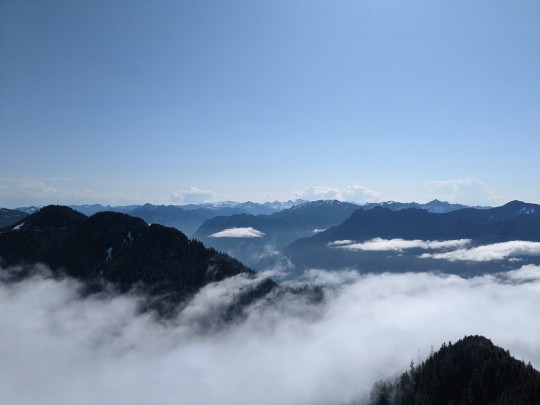
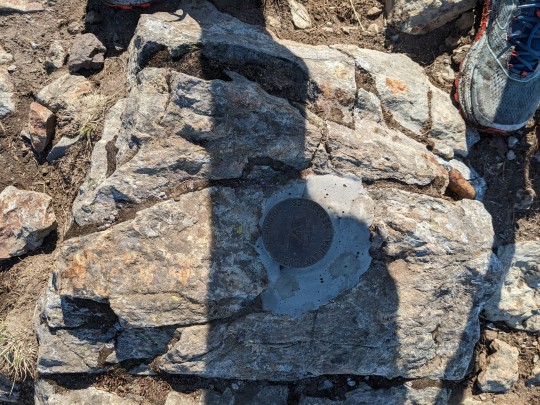

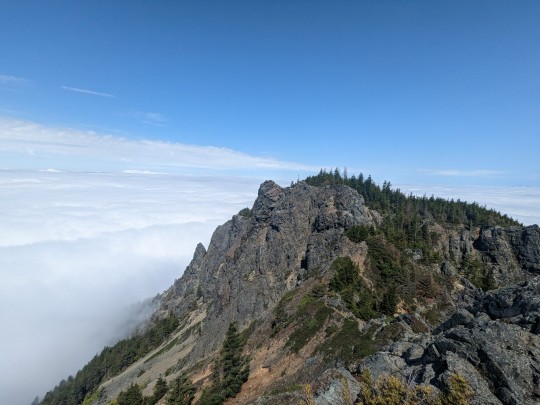
The Monday after, a friend and I tried an even more daring loop circumnavigating Granite Mountain on foot, connecting a bunch alpine lakes on the way (the original plan was to go up to Kaleetan Peak but it was too snowy to get there safely in just running shoes). It was beautiful, but grueling. We ended up doing about 22 miles and almost 9K of vert that day, the first bit moving really slowly with our detour to Kaleetan.

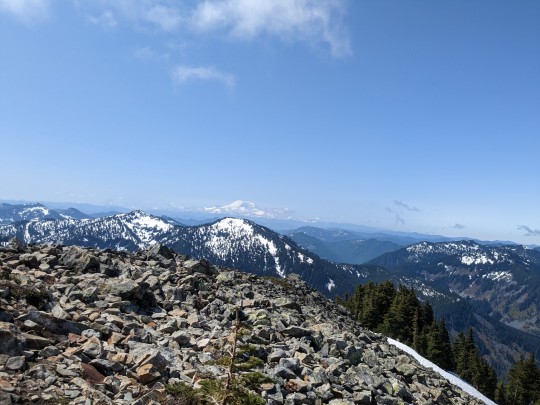
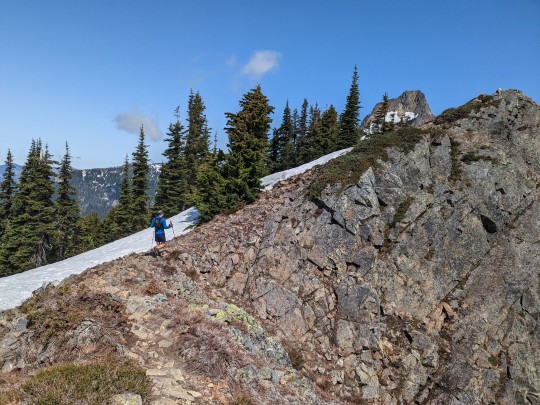


Happy for the change of seasons!
3 notes
·
View notes
Text
This Legendary Polynesian Canoe Will Sail 43,000 Miles, From Alaska to Tahiti
The crew of the Hōkūleʻa is embarking on an arduous 47-month journey across the Pacific Rim.
— By Jill K. Robinson | June 7, 2023

In this 2013 photo, the Hōkūleʻa crew trains in the ancient art of Polynesian wayfinding—navigating without modern tools. The Hōkūleʻa and her sister canoe, the Hikianalia, will embark on a circumnavigation of the Pacific in 2023, connecting Polynesian cultures and highlighting ocean conservation along the way. Photograph By Paul Nicklen, National Geographic Image Collection
The feat of Polynesian wayfinding—navigating by stars, wind, and waves—had long been discounted by scholars on the grounds that ancient Polynesians didn’t have the knowledge to be master navigators. But in 1976, a traditional 62-foot, double-hull voyaging canoe called Hōkūleʻa sailed from Hawaii to Tahiti with a crew of 15, proving that the old ways were more than enough to carry people across the vast ocean.
Now, the next generation of Polynesian wayfarers is stepping up and getting onboard. Beginning June 15 in Alaska, Hōkūleʻa and her sister canoe Hikianalia will set off on a 43,000-nautical-mile, 47-month circumnavigation of the Pacific Ocean. The journey will take them to 36 countries and archipelagoes, nearly a hundred Indigenous territories, and 345 ports. There’ll be about 12 crew on each canoe at a time, switching out about every four weeks, for a total of 400 crew members over four years.
Here’s what to know about this epic voyage.
Hōkūleʻa’s History
Named after Arcturus, the zenith star of the Hawaiian Islands, Hōkūleʻa (“star of gladness”) was conceived and built by the Polynesian Voyaging Society (PVS). This Honolulu, Hawaii-based organization was established to research the means by which Polynesian seafarers found and settled on islands within the immense Pacific Ocean. Since her first voyage, Hōkūleʻa has traveled throughout the globe. Its founders want to explore and reclaim Polynesian culture, traditions, and relationship to both home and the planet.
“Hōkūleʻa allows us to find the connection that a lot of people believed was lost,” says National Geographic explorer Lehua Kamalu, Hōkūleʻa’s first female captain and the voyaging director of PVS.
The Moananuiākea Voyage
Hōkūleʻa’s Moananuiākea (“the vast Pacific”) Voyage embarks this month from Alaska due to a partnership that began in 1990. At that time, the Polynesian Voyaging Society approached the Tlingit, Haida, and Tsimshian peoples of the Sealaska Corporation after searching unsuccessfully for koa logs large enough to build a Hawaiian voyaging canoe from traditional native materials. The nonprofit Alaska Native conservation group gifted the society two Sitka spruce logs.
“That’s why we’re starting in Alaska,” says Randie Fong, leader of ʻAha Moananuiākea Pacific Consortium. “It’s important when we travel that we acknowledge the global Indigenous community and our traditional systems in the pursuit of solutions to climate change and the restoration of our oceans and landscapes.”
“We wanted to bring it all home to the Pacific, because our culture is here,” says navigator and PVS president Nainoa Thompson. “We know that the great systems of the planet are connected. We don’t have a number of different oceans. They’re all one.”

The Hōkūleʻa is a 62-foot waʻa kaulua, a double-hull voyaging canoe open to the elements. “While it helps that I’ve sailed her and understand how she works, in bad conditions you’re in survival mode,” says Captain Lehua Kamalu. Photograph By Paul Nicklen, National Geographic Image Collection
How to Follow the Hōkūleʻa
As Hōkūleʻa and Hikianalia journey on the Moananuiākea Voyage, their paths will be tracked on Hokulea.com so anyone can follow along. The website will also post specific port dates throughout the journey.
From Alaska, the canoes sail along the west coasts of North and South America, through Polynesia and north along the West Pacific. Hōkūleʻa will then be shipped from Japan to Los Angeles to sail home to Hawaii. From there, it will voyage to Tahiti in the spring of 2027.
“The ocean will do what it wants,” says Kamalu. “Hōkūleʻa is an open vessel, so we’re highly exposed and there’s no way to hide from heavy weather. Your skin may be soggy for days.”
While the crew will most certainly face challenges along the way, the measure of success isn’t about how much hardship they can take, but what they’re responsible for—making sure that the next generation of wayfinders can take things even farther.
To that end, the Polynesian Voyaging Society has also launched Wa’a Honua, the Canoe for the Earth. The virtual global hub is meant to inspire people to become future navigators for the planet. “This voyage and its impacts reach far beyond the crew that sails,” says Kamalu.
Hōkūleʻa will likely be at sea for the canoe’s 50th anniversary, on May 1, 2026. But there’s no rush to get to a specific destination for that day. “The beauty of voyaging is not to go fast,” says Thompson. “It’s to go slow and take your time. You can’t look up at the stars and tell where you are. In this kind of navigation, you only know where you are by memorizing where you sailed from.”
3 notes
·
View notes
Photo

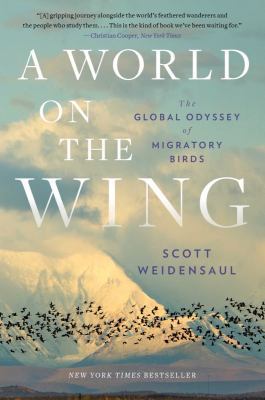


Book Recommendations: National Bird Day
The Secret Perfume of Birds by Danielle J. Whittaker
The puzzling lack of evidence for the peculiar but widespread belief that birds have no sense of smell irked evolutionary biologist Danielle Whittaker. Exploring the science behind the myth led her on an unexpected quest investigating mysteries from how juncos win a fight to why cowbirds smell like cookies. In The Secret Perfume of Birds - part science, part intellectual history, and part memoir - Whittaker blends humor, clear writing, and a compelling narrative to describe how scent is important not just for birds but for all animals, including humans.
Whittaker engagingly describes how emerging research has uncovered birds' ability to produce complex chemical signals that influence their behavior, including where they build nests, when they pick a fight, and why they fly away. Mate choice, or sexual selection - a still enigmatic aspect of many animals' lives - appears to be particularly influenced by smell. Whittaker's pioneering studies suggest that birds' sexy (and scary) signals are produced by symbiotic bacteria that manufacture scents in the oil that birds stroke on their feathers when preening. From tangerine-scented auklets to her beloved juncos, redolent of moss, birds from across the world feature in Whittaker's stories, but she also examines the smelly chemicals of all kinds of creatures, from iguanas and bees to monkeys and humans.
Readers will enjoy a rare opportunity to witness the twisting roads scientific research can take, especially the challenging, hilarious, and occasionally dangerous realities of ornithology in the wild.
A World on the Wing by Scott Weidensaul
In the past two decades, our understanding of the navigational and physiological feats that enable birds to cross immense oceans, fly above the highest mountains, or remain in unbroken flight for months at a stretch has exploded. What we’ve learned of these key migrations - how billions of birds circumnavigate the globe, flying tens of thousands of miles between hemispheres on an annual basis - is nothing short of extraordinary.
Bird migration entails almost unfathomable endurance, like a sparrow-sized sandpiper that will fly nonstop from Canada to Venezuela - the equivalent of running 126 consecutive marathons without food, water, or rest - avoiding dehydration by "drinking" moisture from its own muscles and organs, while orienting itself using the earth’s magnetic field through a form of quantum entanglement that made Einstein queasy. Crossing the Pacific Ocean in nine days of nonstop flight, as some birds do, leaves little time for sleep, but migrants can put half their brains to sleep for a few seconds at a time, alternating sides - and their reaction time actually improves.
These and other revelations convey both the wonder of bird migration and its global sweep, from the mudflats of the Yellow Sea in China to the remote mountains of northeastern India to the dusty hills of southern Cyprus. This breathtaking work of nature writing from Pulitzer Prize finalist Scott Weidensaul also introduces readers to those scientists, researchers, and bird lovers trying to preserve global migratory patterns in the face of climate change and other environmental challenges.
Birds and Us by Tim Birkhead
Since the dawn of human history, birds have stirred our imagination, inspiring and challenging our ideas about science, faith, art and philosophy. Looking to the skies above, we have variously worshipped them as gods, hunted them for sustenance, adorned ourselves in their feathers, studied their wings to engineer flight and, more recently, attempted to protect them.
In Birds and Us, award-winning writer and ornithologist Tim Birkhead takes us on an epic and dazzling journey through this mutual history with birds, from the ibises mummified and deified by Ancient Egyptians to Renaissance experiments on woodpecker anatomy, from Victorian obsessions with egg collecting to the present fight to save endangered species and restore their habitats.
Weaving in stories from his own life as a scientist, including far-flung expeditions to wondrous Neolithic caves in Spain and the bustling guillemot colonies of the Faroe Islands, this rich and fascinating book is the culmination of a lifetime's research and unforgettably shows how birds shaped us, and how we have shaped them.
The Hawk’s Way by Sy Montgomery
When Sy Montgomery went to spend a day at falconer Nancy Cowan’s farm, home to a dozen magnificent birds of prey, it was the start of a deep love affair. Nancy allowed her to work with Jazz, a feisty, four-year-old, female Harris’s hawk with a wingspan of more than four feet. Not a pet, Jazz was a fierce predator with talons that could pierce skin and bone and yet, she was willing to work with a human to hunt. From the first moment Jazz swept down from a tree and landed on Sy’s leather gloved fist, Sy fell under the hawk’s magnetic spell.
Over the next few years, Sy spent more time with these magnificent creatures, getting to know their extraordinary abilities and instincts. They are deeply emotional animals, quick to show anger and frustration, and can hold a grudge for years. But they are also loyal and intensely aware of their surroundings. In this mesmerizing account, featuring sixteen pages of gorgeous color photographs, Sy passionately and vividly reveals the wonderous world of hawks and what they can teach us about nature, life, and love.
#national bird day#birds#birding#birdlife#nonfiction books#nonfiction#Nonfiction Reading#nonfiction reads#library books#book recommendations#book recs#reading recommendations#reading recs#TBR pile#tbr#to read#booklr#book tumblr#book blog
5 notes
·
View notes
Note
So this is just my thoughts, but depending on how the dream realm goes, I wouldn’t be surprised that if there wasn’t a rol for a red for Laudna, the reason I say that is, by using C1 for example, most of those res took place in the following episode. Also from Marisha from 4-sided dive, she doesn’t want to let Laudna go yet. Her response was literally “No”.
This feels like a way to circumnavigate Laudna’s “strangeness” as well as pulling out a meaningful arc from a tragic event.
This seem more involved then a simple res
Hello Anon!
Yes, I agree with you. I want three encounters that will replace the rolls they would normally do for a resurrection ritual. It's very involved, and I think that's primarily because Delilah is a formidable foe. Even still, she's weak and has only managed to drain power from AT MOST two gnarlrock shards. I definitely think they have a good chance at defeating Delilah and banishing her from being resurrected again. There's always a chance she could find another method of coming back, but I personally believe that they're gonna nip this problem in the bud. Had Laudna not died, maybe Delilah would have grown her power until they leveled up enough for it to be an epic boss battle, but she died after going against Thull.
But anyway, yes. I think this is something completely different, and I really hope no one has to roll. If someone has to, I want it to be Pike.
Thank you for the ask!
3 notes
·
View notes
Text

Read the book on Wattpad
cover by @once-upon-a-reblog
THE UNTOLD TALE follows Pip, who is pulled against her will into the epic fantasy novel series she's loved since she was a teenager. However, the world is darker, and far more dangerous than she could have ever predicted, especially when it turns out the hero is a much bigger jerk than she expected him to be.
Pip knows how to circumnavigate the Hero's Journey and the pitfalls and loopholes of this particular world - but what will happen to her beloved characters outside of the comfort of the fantasy they were written for? And what happens when it's not the hero, but the hero's overlooked and bullied little brother who proves to be her biggest champion?
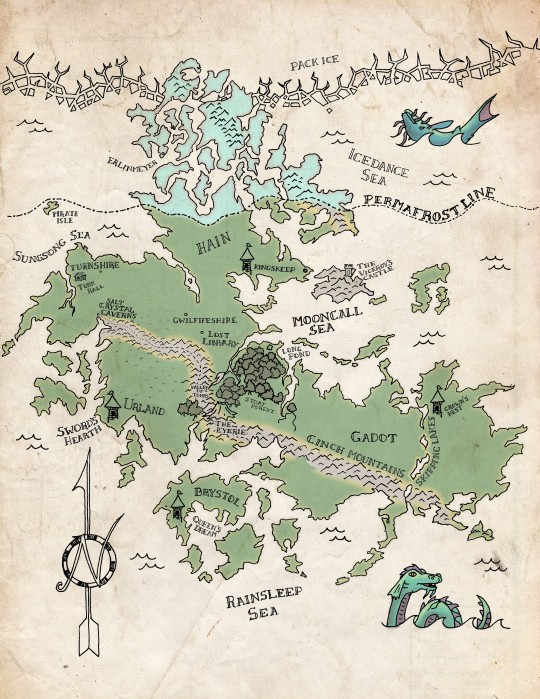
Map by Christopher Winkelaar
I originally published "The Untold Tale", book one of the Accidental Turn series waaaay back in 2015 with an indie publisher. I'm re-releasing the whole series late 2023/early 2024 under my own imprint, with all new covers and some updated interiors. To celebrate, I've decided to give all of you a treat and release the WHOLE first book of the series in it's entirety.
Chapters will drop every Tuesday, and it will be totally free to read. You just have to have a Wattpad account (which is also free, though it does have premium versions and in-app purchases for some pay-walled stories).
And if you like the book, you can find out about the rest of the series on my website. AND, if you want to be in the loop when the paperback and eBook editions are re-released, make sure to sign up for my newsletter (head to my website, and scroll to the bottom of the page.)
Happy Reading!
#J.M.Frey#jmfrey#wattpad#wattpad star#losyark#cling fast#cling fast adjacent#the accidental turn series#fantasy#portal fantasy#epic fantasy#fantasy series#fantasy trilogy#romantic fantasy#romantasy#fantasy romance#queer side characters#romance#free book#writing#original fiction#wattpad romance#wattpad fantasy#fiction#freebie
24 notes
·
View notes
Text
Trailblazing Adventures: Discover the World's Most Breathtaking Hikes
Hiking allows adventurers to connect with nature, challenge their physical limits, and witness some of the planet's most awe-inspiring vistas. Each trail offers a unique journey into the wilderness, from towering peaks to lush rainforests. Here's a guide to some of the world's most breathtaking hikes that promise unforgettable experiences for trailblazers of all levels.
Journey Through the Americas: Patagonia's Torres del Paine
In Chile's Patagonia region, Torres del Paine National Park is famed for its rugged terrain and dramatic landscapes. The W Trek is particularly popular, guiding hikers through a path with stunning views of mountain spires, glacial lakes, and vast ice fields. This trek can be completed in about five days, making it a perfect blend of accessibility and adventure.
Europe's Alpine Spectacle: The Tour du Mont Blanc
This famous trail circumnavigates the Mont Blanc massif and traverses three countries: France, Italy, and Switzerland. Offering a feast for the eyes, it covers nearly 170 kilometers and takes around 11 days to complete. Hikers are treated to an ever-changing backdrop of some of the Alps' highest peaks, charming meadows, and picturesque villages.
Asia's Dragon Backbone: The Dragon's Back, Hong Kong
Contrary to the bustling cityscapes that define Hong Kong, the Dragon's Back trail presents a serene escape into the region's natural beauty. This relatively short hike is ideal for beginners and offers panoramic views of the South China Sea, lush green hills, and sandy beaches. It's a refreshing day trip that contrasts sharply with the city's urban environment.
Africa's Snow-Capped Challenge: Mount Kilimanjaro, Tanzania
Mount Kilimanjaro is Africa's highest peak and a dream destination for serious hikers. The journey to the summit takes you through five different climatic zones, from rainforest conditions at the peak. Climbing Kilimanjaro requires no technical skills, making it accessible to anyone in good physical condition. Depending on the route chosen, it can take about 5 to 9 days.
North America's Iconic Crest: The Pacific Crest Trail
Stretching from Mexico to Canada, the Pacific Crest Trail (PCT) showcases the beauty of the American wilderness over an epic 4,265 kilometers. Few attempt the entire trail due to the commitment required, but shorter segments offer the beauty of the Sierra Nevada and Cascade ranges. Those looking for a life-changing journey often find it along the PCT, encountering diverse ecosystems and breathtaking landscapes.
Oceania's Coastal Gem: The Routeburn Track, New Zealand
Linking Mount Aspiring National Park with Fiordland National Park, the Routeburn Track is a marvel of New Zealand's South Island. This three-day trek spans 32 kilometers and offers hikers majestic views of alpine lakes, vast rock faces, and ancient forests. Its diverse landscapes make it one of the most photogenic trails in the world.
Embracing the Journey
Each of these trails offers more than just a physical challenge; they are a means to explore the beauty and diversity of our world. Hiking them allows one to disconnect from the digital world and reconnect with nature. Whether you're a seasoned hiker or just starting, these trails provide a gateway to some of the most unforgettable natural environments on the planet.
Remember, preparing adequately for these hikes is crucial. This includes researching the best times to visit, understanding the physical demands, arranging necessary permits, and packing appropriate gear. Always respect local guidelines and practices to preserve the natural beauty for future adventurers.
Embarking on these hikes promises awe-inspiring views and an opportunity for personal growth and introspection. Each step on these trails is a step towards understanding the world and oneself better. So, lace up your boots, pack your spirit of adventure, and explore the peaks and valleys of our incredible planet.
0 notes
Text
The Flying Dutchman Ghost Story
The Flying Dutchman mythology, which tells the haunting story of a ghost ship destined to cruise the waters forever, has captivated the minds of seafarers for ages. The Flying Dutchman is said to be a ghostly ship doomed to cruise the seas for all eternity, unable to ever dock. Often depicted glistening with an unearthly light, the ship emerges from the midst of storms or turbulent waters, terrifying everyone it encounters.
Although accounts of the Flying Dutchman legend's beginnings differ, most of them center on a Dutch captain by the name of Van der Decken. He encountered a strong storm during his 17th-century attempt to circumnavigate the dangerous Cape of Good Hope. According to some tellings of the story, he vowed in despair or hubris to carry on with his journey, even if it meant sailing until Judgment Day. As retribution for their blasphemy or rebellion, God cursed him and his ship to sail the waves for all eternity, never finding a safe harbor. Other interpretations of the tale suggest that Van der Decken made a deal with the devil, exchanging his soul for endless prosperity at sea, only to fall victim to an endless life of wandering.

Through the ages, sailors have reported seeing the ghostly ship; they have frequently described it as an ethereal craft with frayed sails and a ghostly crew. People usually interpret these experiences as portents of impending disasters or bad luck. People claim to see the Flying Dutchman in the distance, shimmering with an ethereal radiance and occasionally accompanied by weird noises or eerie lights. According to sailors' accounts, the ship emerges abruptly from a mist or storm, then disappears again in an instant, leaving a spooky silence behind it.
The mythology of the Flying Dutchman, deeply embedded in popular culture, has influenced numerous pieces of music, film, and literature. One of the most well-known versions is the opera The Flying Dutchman by Richard Wagner, which transforms the tale into a dramatic tale of love and redemption. The opera portrays the Dutchman as a cursed captain, set free from his ghostly state only by the genuine love of a devoted woman. This romanticized retelling of the narrative highlights themes of sacrifice and unending love, giving the story a tragic poignancy.
Famous writers, including Sir Walter Scott, Samuel Taylor Coleridge, and Washington Irving, have all written about the Flying Dutchman. Coleridge's epic poem The Rime of the Ancient Mariner doesn't explicitly mention the Flying Dutchman, but it echoes themes of supernatural punishment and marine terror. Numerous movies and TV series have also portrayed the ghost ship as an enigmatic and eerie presence on the high seas. The Pirates of the Caribbean film franchise further cements the Flying Dutchman's image in the public consciousness by depicting it as a cursed ship under Davy Jones' command.

The Flying Dutchman legend may be legendary, but it speaks to deeper themes of human ambition, nature's opposition, and the paranormal fallout from one's choices. It is a warning story that serves to remind both landlubbers and mariners of the dangers of arrogance and the enigmatic, sometimes violent, force of the ocean. The mythology alludes to the fear of the unknown and the uncontrollable natural elements that have long pervaded nautical life. The sea is a source of constant danger as well as a means of subsistence for sailors, and the Flying Dutchman personifies the worst kind of nautical nightmare: a continuous journey without any chance of rest.
Many generations to come will tell and repeat The Flying Dutchman's story due to its enduring quality, which resonates with people's enduring curiosity about the paranormal and the unknown. It appeals to our shared concerns about being alone, suffering forever, and the repercussions of disobeying the laws of nature. The spectral image of the Flying Dutchman will continue to be a powerful representation of the secrets and perils that lurk under the seas for as long as people go out into the wide, unpredictable oceans.
1 note
·
View note
Text
Events 7.21 (after 1950)
1951 – Canadian Pacific Air Lines Flight 3505 disappears while flying from Vancouver to Tokyo. The aircraft and its 37 occupants are never found.
1952 – The 7.3 Mw Kern County earthquake strikes Southern California with a maximum Mercalli intensity of XI (Extreme), killing 12 and injuring hundreds.
1954 – First Indochina War: The Geneva Conference partitions Vietnam into North Vietnam and South Vietnam.
1959 – NS Savannah, the first nuclear-powered cargo-passenger ship, is launched as a showcase for Dwight D. Eisenhower's "Atoms for Peace" initiative.
1959 – Elijah Jerry "Pumpsie" Green becomes the first African-American to play for the Boston Red Sox, the last team to integrate. He came in as a pinch runner for Vic Wertz and stayed in as shortstop in a 2–1 loss to the Chicago White Sox.
1960 – Sirimavo Bandaranaike is elected Prime Minister of Sri Lanka, becoming the world's first female head of government
1961 – Mercury program: Mercury-Redstone 4 Mission: Gus Grissom piloting Liberty Bell 7 becomes the second American to go into space (in a suborbital mission).
1961 – Alaska Airlines Flight 779 crashes near Shemya Air Force Base in Shemya, Alaska killing six.
1964 – A series of racial riots break out in Singapore. In the next six weeks, 23 die with 454 others injured.
1969 – Apollo program: At 02:56 UTC, astronaut Neil Armstrong becomes the first person to walk on the Moon, followed 19 minutes later by Edwin "Buzz" Aldrin.
1970 – After 11 years of construction, the Aswan High Dam in Egypt is completed.
1972 – The Troubles: Bloody Friday: The Provisional IRA detonate 22 bombs in central Belfast, Northern Ireland, United Kingdom in the space of 80 minutes, killing nine and injuring 130.
1973 – In Lillehammer, Norway, Mossad agents kill a waiter whom they mistakenly thought was involved in the 1972 Munich Olympics Massacre.
1976 – Christopher Ewart-Biggs, the British ambassador to the Republic of Ireland, is assassinated by the Provisional IRA.
1977 – The start of the four-day-long Libyan–Egyptian War.
1979 – Jay Silverheels, a Mohawk actor, becomes the first Native American to have a star commemorated in the Hollywood Walk of Fame.
1983 – The world's lowest temperature in an inhabited location is recorded at Vostok Station, Antarctica at −89.2 °C (−128.6 °F).
1990 – Taiwan's military police forces mainland Chinese illegal immigrants into sealed holds of a fishing boat Min Ping Yu No. 5540 for repatriation to Fujian, causing 25 people to die from suffocation.
1995 – Third Taiwan Strait Crisis: The People's Liberation Army begins firing missiles into the waters north of Taiwan.
2001 – At the conclusion of a fireworks display on Okura Beach in Akashi, Hyōgo, Japan, 11 people are killed and more than 120 are injured when a pedestrian footbridge connecting the beach to JR Asagiri Station becomes overcrowded and people leaving the event fall down in a domino effect.
2005 – Four attempted bomb attacks by Islamist extremists disrupt part of London's public transport system.
2008 – Ram Baran Yadav is declared the first President of Nepal.
2010 – President Barack Obama signs the Dodd–Frank Wall Street Reform and Consumer Protection Act.
2011 – NASA's Space Shuttle program ends with the landing of Space Shuttle Atlantis on mission STS-135 at NASA's Kennedy Space Center.
2012 – Erden Eruç completes the first solo human-powered circumnavigation of the world.
2019 – Yuen Long attack or "721 incident" in Hong Kong. Triad members indiscriminately beat civilians returning from protests while police failed to take action.
2023 – The Barbenheimer phenomenon begins as two major motion pictures, Greta Gerwig's fantasy comedy Barbie and Christopher Nolan's epic biographical thriller Oppenheimer, are released in theaters on the same day and audiences, instead of creating a rivalry between the extremely dissimilar films, instead attend and praise both as an informal, surreal double feature.
0 notes
Text
Italy III: Dolomites Trek (2/2)
Continued from the previous post on the Dolomites Trek...
Day 4: We hiked most of the popular Sassolungo Circuit Hike, starting at Rifugio Valentini and ending at Rifugio Sasso Piatto. Sassolungo (“long stone”) is a notable mountain that is large enough to make a day out of circumnavigating it.
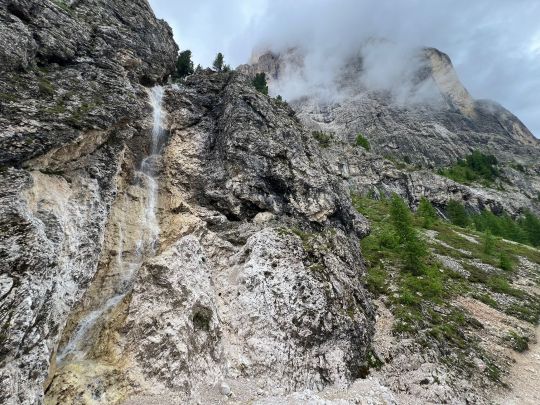
Sassolungo
The beginning was mostly flat and downhill through a beautiful area that looked like a botanical garden.
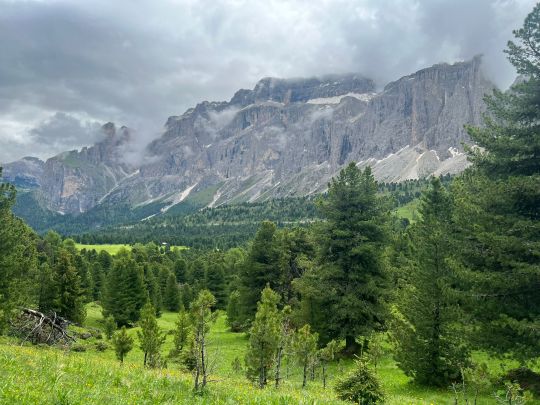
Mountain views near the "botanical garden"
After an ~hour we hit a Mercedes-sponsored rifugio that had very luxurious bathrooms (uplighting, etc.).

Cows by the Mercedes rifugio
From there we walked uphill for a couple hours, mostly along the side of the cliff with stunning views of the valley below, and then stopped for lunch at Rifugio Vicenza along the way (the gnocchi was great).

Walking uphill along Sassolungo
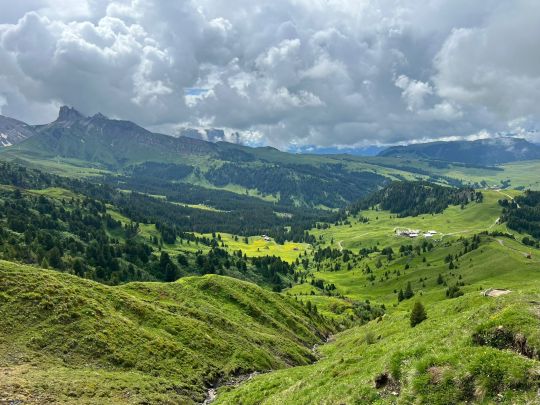
Valley views

View of Rifugio Vicenza
After lunch we continued for a couple hours to Rifugio Sasso Piatto – I don’t really remember this part of the hike. This was one of our easier and shorter hiking days, and given the popularity and comparative ease of this trail, we encountered many more tourists, and more Americans than any other day of the trek.

More walking
Rifugio Sasso Piatto was the most crowded rifugio we stayed at, and we had to stay in a shared dormitory (bunk beds with 10 spots, though luckily 4 spots remained empty) because the private rooms were booked out by the time we reserved our trek ~6 weeks in advance. The shared dormitory was not quite as bad as expected (Nyquil + Loop earplugs + eye mask did the trick) and the food was pretty good.
Day 5: This was the most epic day, and the most difficult. Pretty much every part of this ~9-hour day was surreally beautiful, starting with the first couple of hours through Alpine meadows dotted with sheep, cows, and horses. There were a few times we had to walk right by cows and bulls that were not fenced in and seemed skittish.
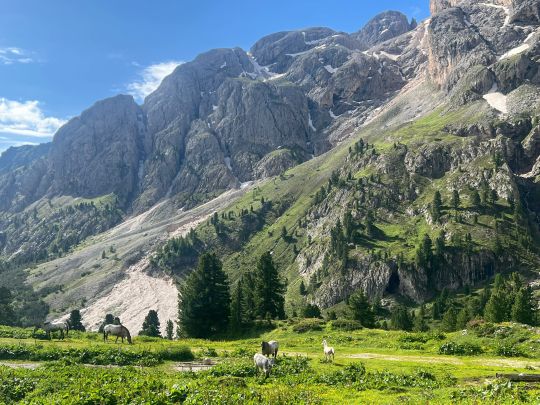
We saw a horse scaring off a skittish bull

Sassolungo
About 4 hours in, by the time we reached Rifugio Antermoia, the landscape had really changed.

Rifugio Antermoia
We walked around an insane glacial lake (strong Banff teahouse hike vibes) to encounter Passo d’Antermoia – a pass that our trek organizer had warned us might require us to walk in snow up to our knees, and that stood between us and the recommended lunch spot, Rifugio Passo Principe.
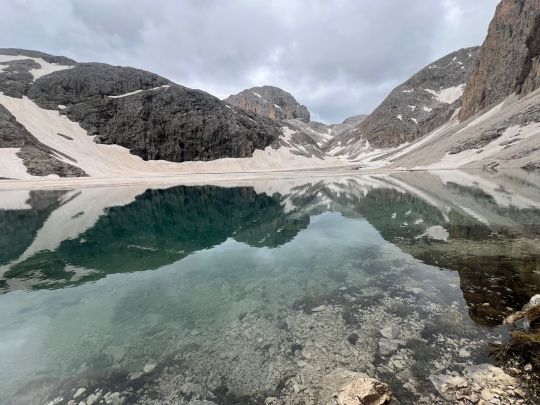
The glacial lake

Trying to make it up Passo D'Antermoia

View from the top of the pass
Despite the organizer’s caveat, I had not expected that we’d effectively be walking up a ski slope so steep that it would have been difficult without the snow (particularly with a pack weighing 20-25% of my body weight), let alone now slipping and sliding down it in the wintery conditions, even with crampons. This Sisphyean hike was the first time in the trek that I was not sure I would make it to the next rifugio – the second time being when we eventually reached the top and saw that we had to descend just as steep a downhill, which we found even harder and resulted in many slips and falls (thankfully cushioned by lots of snow).

Some of the perilous downhill (this photo does not do it justice)
We saw almost no one else on this path, though we did spot a few via ferrata hikers who actually donned their helmets for this descent. It took us 2x the budgeted amount of time to complete, and when we finally, miraculously reached Rifugio Passo Principe, we were more than a little disappointed to find that it was closed and under construction. So much for lunch after 7 hours of intense hiking!
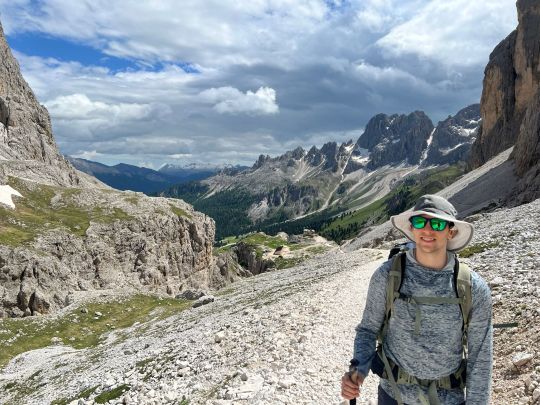
Heading down from Passo Principe
Luckily, after continuing along down a scenic valley surrounded by mountains for about 40 minutes, we encountered Rifugio Vajolet, which had the first and only vegan food menu we found in the Dolomites. The food was a delight, and couldn’t have been a more timely reward for us.

Rifugio Vajolet's vegan crepe with mushrooms, gnocchi with soy ragu, and salad with eggs, beans, and cheese really hit the spot.
After this, we had just another ~40 minutes descent to Rifugio Stella Alpina, where the very sweet proprietress welcomed us and just 1 other guest for the night. The rifugio was comfortable and clean, with some of the more basic food we ate. It was quite an experience waking up to cows mooing and jangling their bells.
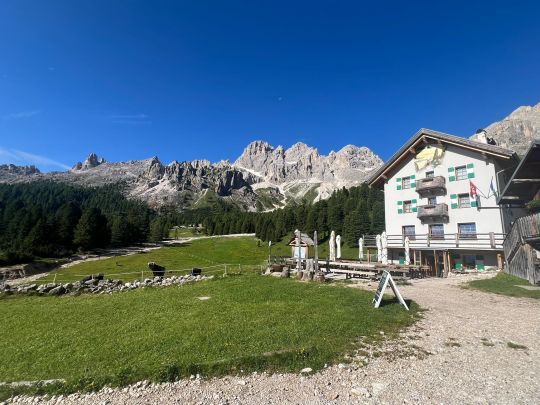
Rifugio Stella Alpina
Day 6: Sadly, our last day’s hiking itinerary was almost entirely disrupted due to snow. We only hiked about an hour from Stella Alpina over to the town of Ciampedie, where we took a quick cable car down to Vigo di Fassa, the largest town we had seen all week.
From there we took a ~30 minute bus ride down to Lago di Carezza, a very clear, highly Instagrammable lake with a flat ~25 minute walk around its circumference. Both the bus and the lake were very crowded with tourists. It was nice, but in my opinion, didn’t hold a candle to any of the hikes we did.
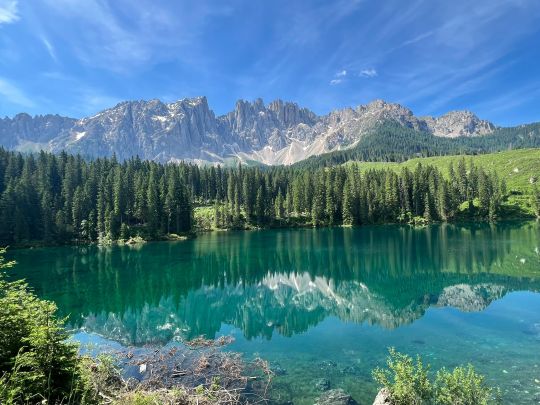
Lago di Carezza
We ended our trip with a bus ride up to Castel Latemar, the basic hotel that we were put up in for our first and last nights. We grabbed a pretty good lunch nearby at Hennenstal Restaurant, whose menu thankfully offered a few non-Tyrolean food options (pizza! Grilled vegetables!) – refreshing after a week of eating the same few things every day.
Food
We were expecting to eat delicious Italian food every day in the Dolomites. In reality, we mostly ate Tyrolean food, which we came to learn is quite different. As vegetarians, our options were limited to a few common dishes that were available at pretty much every hut:
Fried eggs with slices of baked potato
Polenta with sauteed mushrooms and thick slices of swiss cheese

A very basic “mixed salad” of lettuce, raddichio, shredded carrots, corn (and a few lucky times, beans). Two of our rifugios also had a salad bar at dinner, which thankfully had more ingredient options.
Canederli – a traditional dumpling-like dish that was delicious and also the most buttery thing I have ever eaten in my entire life
Pasta (sometimes) – the pro tip here is to always get the types of pasta that are made fresh (e.g., tagliatelle, gnocchi, ravioli) and not those that are dry pastas (e.g., spaghetti, penne). The fresh pastas we ate in the Dolomites were generally pretty good, if typically not as good as Italian food we’ve had in other parts of Italy, whereas the dry pastas tasted like American “Italian” food.

The spaghetti at Rifugio Contrin was a bit like a kids' meal at an Olive Garden...
Cheese plate – A couple of places had a “cheese plate” but this really only consisted of various cheeses and maybe a jam, without the expected fruit or nuts we’re accustomed to in the U.S.
Desserts: Tiramisu, apple strudel, ice cream – though we usually skipped these and asked for fruit. Tyrol is known for its apples, and Rifugio Dolomia served us really delicious apples for dessert.
Breakfast: We always had the same thing – bread + cheese + boiled egg (except for Rifugio Contrin, which didn’t even offer eggs) and yogurt + muesli (only Rifugio Valentini offered any fresh fruit at breakfast). There were usually also various pastries and jams available.
A note on water: Some of the rifugios had potable water and others didn't. Sometimes they had these structures for refilling water bottles and bladders, but the water from these spouts was sometimes not potable -- always worth asking first!
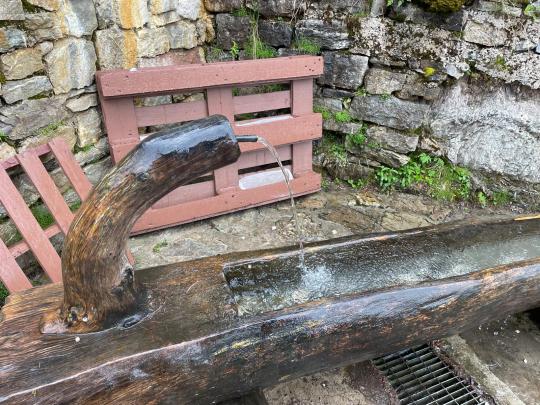
We were very glad to have packed lots of protein-heavy snacks for the trek (protein powder, nuts, edamame, vegan jerky, protein bars). By the end, we were relieved to return to a greater variety of food options and availability of fresh fruit and vegetables (yay fiber!).
Overall, the Dolomites trek was one of the coolest ways I’ve ever spent a week. It made me a bit more confident in my backpacking abilities, and it was also humbling to encounter many incredibly fit hikers (Europeans set a high bar!). It was helpful having the trip organized by a knowledgeable operator and traversing less crowded areas than many of the standard Dolomites day hikes. I’d gladly go back to the Dolomites – they are vast and there are so many other parts to explore!
0 notes